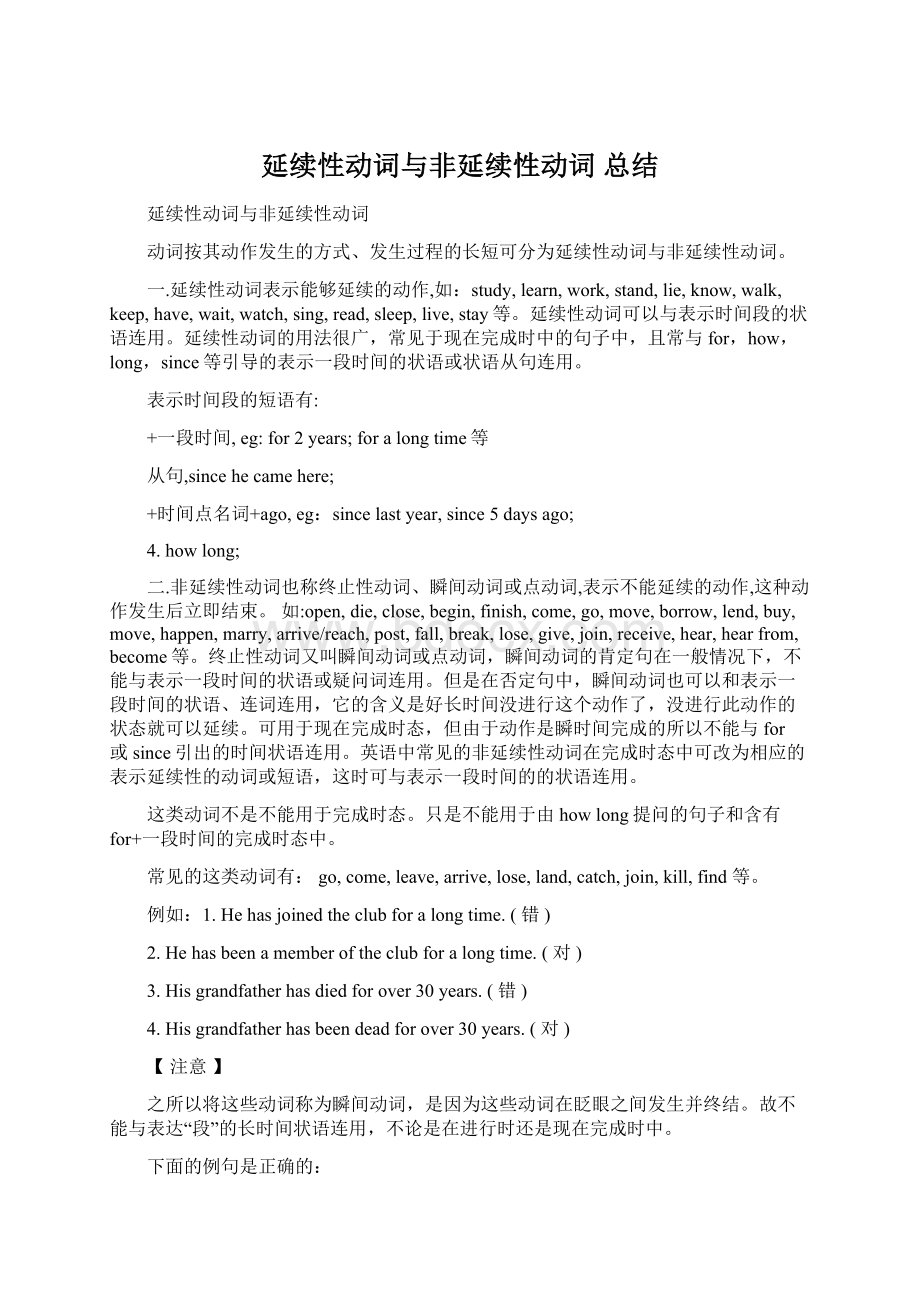延续性动词与非延续性动词 总结文档格式.docx
《延续性动词与非延续性动词 总结文档格式.docx》由会员分享,可在线阅读,更多相关《延续性动词与非延续性动词 总结文档格式.docx(8页珍藏版)》请在冰豆网上搜索。

1.Hehasjoinedtheclubforalongtime.(错)
2.Hehasbeenamemberoftheclubforalongtime.(对)
3.Hisgrandfatherhasdiedforover30years.(错)
4.Hisgrandfatherhasbeendeadforover30years.(对)
【注意】
之所以将这些动词称为瞬间动词,是因为这些动词在眨眼之间发生并终结。
故不能与表达“段”的长时间状语连用,不论是在进行时还是现在完成时中。
下面的例句是正确的:
1.Heisdying.
2.Hehasdied.
一个生物体是死是活,界与其终结生命的前与后的一霎那,如果上述例句加上了表达段的时间状语,试请问:
该人是死是活?
但是,有几个表示去向的非延续性动词如go,come,start,leave等,可以同表示时间段的状语for短语连用。
但要注意,这种用法的for短语表示的不是句中谓语动词延续的时间,而是该动词动作完成后再做某事所需要的时间。
1.ShehasgonetoNanjingforthreedays.(=She’scomehere,intendingtostayforthreedays.)
2.AlicehasleftforParisforthreemonths.(=AlicehasleftforParis,intendingtostaythereforthreemonths.)
3.WearestartingforShanghaifortwoweeks.(=WearegoingtoShanghai,andweareplanningtostaytherefortwoweeks.)
学生如果遇到与第一点所不符的情况,如本点所讲述,不要轻易下结论为“错题”,应该认真分析后再做结论。
比如我们学过了这样的结构:
makesomebodydosomething;
而我们常可见到这样的句子:
Hemadeacandletogivelight.
在这个句子中的宾语后面明显带了to,与短语所表达的不符,但我们不要忘了:
make的基本意思为“制造”,并且,不定式结构在短语中充当宾语补足语,而在例句中充当状语。
非延续性谓语动词后有非谓语动词时,可与表示一段时间的状语连用,这时,时间状语所修饰的不是句中的谓语动词,而是非谓语动词。
1.Shewenttoworkfortwoweeks.(fortwoweeks修饰towork)
2.HebegantoreadEnglishforoveranhour.(foroveranhour修饰toread.)
了解了上述第二点,这一点要好理解的多:
一般情况下,这些状语都会放在所修饰的动词或短语附近,稍加分析则不会产生误解。
如果非延续性谓语动词是否定完成时时,表示的是一种状态,故可同表示一段时间的状语连用;
如果非延续性谓语动词的完成时表示经常重复的行为,可同表示时段的时间状语连用,但应慎用。
1.Shehasn’ttakenpartinlaborforweeks.
2.IhaveoftengonetoBeijingsince1985.
这一点的关键是:
完成时表达的是“状态”,而后面表达段的时间是:
“这种状态持续了如此长的时间”。
在不同的语言环境中,有些动词可以作延续性动词或非延续性动词,如:
sit,walk,move,run,feel等。
1.Hesatinthegrass,watchingthesunrising.(延续性动词)
2.Hesatinthegrassandbegantoread.(非延续性动词)
这种用法较为灵活。
所以也应灵活分析。
从上面的两个句子中我们可以看到:
不在具体的句子中,我们无法分清哪个是非延续动词,哪个是延续性动词。
只有根据上下文的意思,才好决定。
非延续性动词在肯定句中与表示时间点的状语连用,如:
twoyearsago;
at5o'
clock;
例:
Heunfortunatelypassedawaylastyear.他去年不幸逝世。
Hedied5yearsago.
否定的终止性动词可以与表示时间段的时间状语连用。
例:
Ihaven'
tleftherefor3years.Ihaven'
theardfromhimfor3weeks.
theardfrommyparentsforalongtime.
我有好长时间没收到父母来信了。
Hehasn'
tlefthomeforaweek.他有一个星期没出门了。
如果要与for+时间段,since+年份,since+时间段+ago,howlong连用时,瞬间性动词要变延续性动词。
三.延续性动词与非延续性动词之间的转换:
非延续性动词
延续性动词
leave
beaway(from)
borrow
keep
buy
have
begin/start
beon
die
bedead
finish
beover
join
bein+组织机构;
beamemberof+组织机构
opensth.
keepsth.open
comehere
behere
gothere
bethere
become
be
comeback
beback
cometo/getto/arrive(in/at)/reach/
moveto
be(in)/stay(in/at)
livein
go(get)out
beout
puton
wear
fallill
beill
getup
beup
catchacold
haveacold
fallasleep
beasleep
gettoknow
know
wakeup/getup
close
beclosed
getmarried
bemarried
例:
(1)他死了三年了。
误:
Hehasdiedforthreeyears.
正:
Hehasbeendeadforthreeyears.
Hediedthreeyearsago.
Itisthreeyearssincehedied.
Threeyearshaspassedsincehedied.
(2)他来这儿五天了。
Hehascomehereforfivedays.
Hehasbeenhereforfivedays.
Hecameherefivedaysago.
Itisfivedayssincehecamehere.
Fivedayshaspassedsincehecamehere.
(1)、
(2)句中的die、come为终止性动词,不能与表示"
段时间"
的状语连用。
那么,应如何正确表达呢?
可以采用下面的四种方法:
(1)将句中终止性动词转换为相应的延续性动词,如上面两例中的第一种正确表达方式.
(2)将句中表示"
的状语改为表示过去确定时间的状语,如下面两例中的第二种正确表达方式。
(3)用句型"
Itis+段时间+since..."
表达原意,如上面两例中的第三种正确表达方式。
(4)用句型"
时间+haspassed+since..."
表达原意,如上面两例中的第四种正确表达方式。
四、终止性动词可用于现在完成时否定式中,成为可以延续的状态,因而可与表示一段时间的状语连用。
如:
hasn'
tleftheresince1986.
haven'
theardfrommyfatherfortwoweeks.
五、终止性动词的否定式与until/till连用,构成"
not+终止性动词+until/till..."
的句型,意为"
直到……才……"
。
如:
1.Youcan'
tleavehereuntilIarrive.直到我到了,你才能离开这里。
2.IwillnotgotobeduntilIfinishdrawingthepicturetonight.
今天晚上直到我画完画,我才上床睡觉。
六、终止性动词可以用于when引导的时间状语从句中,但不可以用于while引导的时间状语从句中。
when表示的时间是"
点时间"
(从句谓语动词用终止性动词),也可以是"
(从句谓语动词用延续性动词)。
而while表示的是一个较长的时间或过程,从句谓语动词用延续性动词。
1.WhenwereachedLondon,itwastwelveo'
clock.(reach为终止性动词)
2.Pleaselookaftermydaughterwhile/whenweareaway.(beaway为延续性动词短语)
七、终止性动词完成时不可与howlong连用(只限于肯定式)。
Howlonghaveyoucomehere?
Howlonghaveyoubeenhere?
Whendidyoucomehere?
误区
[一]
瞬间动词的完成时误区之一是:
现在完成时表达的是“从前发生的动作”,“延续到现在”。
而瞬间动词一瞬间便完成了从发生到结束的全过程,能有完成时吗?
现在完成时虽然动作“发生在过去”但其“影响”持续到现在。
因整个存在的时间短,所以其完成时不与表达“段”的时间连用。
[二]
瞬间动词的进行时误区二:
leave,come等终结性动词,没有进行时的形式。
例如come这一个词,(尤其在肯定句中,可参见第四点)不与表达段的时间状语连用。
比如我们不说:
Hehascomefordays.而要说:
Hecamedaysago.或:
It’sdayssincehecame.常说的Heiscoming./Heisleaving./Heisdying等,并不是表示动作“正在进行”,而是表示“动作即将发生”。
补充练习:
hearrivedatthebusstop,thebus___for20minutes.
A.hasleftB.hadleft
C.hasbeenawayD.hadbeenaway
2.I_____theLeaguefor5yearssofar.
A.joinedB.havejoined
C.havebeenin
factory_____sincetheFebruaryof1988.
A.hasbeenopenB.hasopened
C.wasopenD.opened
4.MaryandRose_______friendssincetheymetin2000.
A.havemadeB.havebeen
C.madeD.havebecome
mustn'
t____untilhecomesback.
A.beawayB.leaveC.beleft
meeting_______foraweeknow.
A.hasfinishedB.hasended
C.hasbeenover
Gao______thisschoolfornearly5years.
A.hasbeeninB.hascometo
C.hastaught
______ateacherfor4years.
A.hasbeenB.hasbecome
C.wasD.became
9.I______homeforaweek.
A.havereturnedB.havebeenback
C.returned
10.Howlong_______he________?
A.diedB.has,died
C.has,beendead
eightyesterdayafternoon.
A.sleptB.wassleeping
C.hassleepD.hadslept
________thecarforaweek.
A.boughtB.hasbought
C.hashad
long_____you_____ill?
-----Twoweeks.
A.didfallB.have,fell
C.have,been
2000,he_____hishometown.
A.hasleftB.hasmovedaway
C.hasbeenawayfrom
'
lllendyouthebook,butyoucanonly____itfor2days.
A.borrowB.keepC.take
bus______ontheroadfor2hourssofar.
A.hasstoppedB.stoppedC.hasbeen
you_____thejacketthesedays?
A.wearingB.puttingon
C.dressingD.on
18.He________foe2hours.
A.gotupB.hasgotupC.hasbeenup
19.Tomisillinhospital.He_______acoldforseveraldays.
A.isB.catches
C.hascaughtD.hashad
20.-----HowlongcanI______thebook?
------Twoweeks.
A.borrowB.lend
C.getD.keep
练习答案
1---5DCABB;
6---10CAABC;
11---15BCCCB;
16---20CACDD